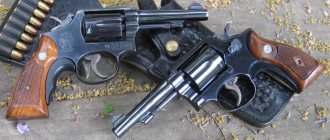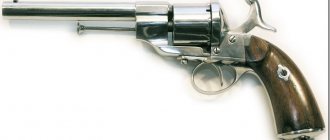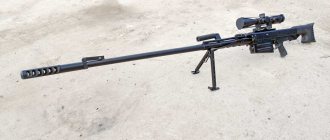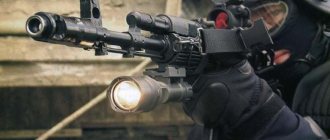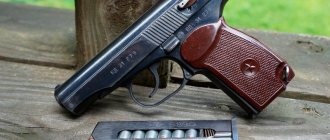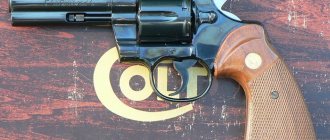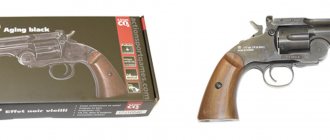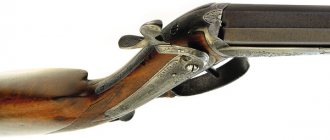Smith-Wesson revolver Russian cartridge, caliber 10.67 mm. Device
4.2-linear (10.67 mm) Smith-Wesson Model III revolver (1871), Russian model, is an American revolver used in the US Army and the Russian Empire in the 19th century.
"Smith and Wesson" is the name of the statutory revolver. Used in Russia in the 19th century.
Back in 1859, the Russian Minister of War, with the consent of Emperor Alexander II, raised the issue of replacing muzzle-loading smooth-bore pistols in the cavalry with rifled breech-loading revolvers, following the example of other countries. However, the solution to this problem took more than ten years. Major General A.P. Gorlov, who had been a Russian military agent in the United States since 1868, singled out the Remington single-shot pistol and revolver and the Smith and Wesson revolver from various samples of breech-loading personal weapons chambered for a unitary cartridge, giving preference to the latter system. In 1869, she introduced a revolver with a barrel that folded down and extraction of spent cartridges using an automatically operating extractor. The design, known as the Smith & Wesson Model No. 3, allowed the use of relatively powerful cartridges, ensured rapid loading and simultaneous extraction of cartridges. For Russia, the Smith and Wesson revolver was modified based on the comments of Russian specialists, and in 1871, a 4.2-line (10.67 mm) revolver, known as the Smith and Wesson Model I, was adopted into service with the Russian Army. In the same year, the Russian government issued an order for the production of revolvers.
The “breaking” design revolver was chambered for a unitary cartridge with a brass sleeve, a charge of black gunpowder, a jacketless lead bullet, and a central Berdan-type primer. The barrel with the drum was connected to the frame by a lower hinge and was fixed with an upper latch; it had a bar on top, and a bulge-case for the ejector rod on the bottom.
The drum had 6 chambers, its central tube was put on a tubular axis. When the barrel was tilted down, a special latch at the bottom of the frame turned a gear wheel, which captured the rack and pulled back a star-shaped extractor from the drum, pushing out the cartridges. At the end of the turn, the gear broke off the latch, and the ejector, under the action of its spring, returned to the recess at the end of the drum (extraction scheme patented in the USA in 1871 by J. Scofield).
The hammer-type trigger mechanism, with an open hammer, provided release only with preliminary cocking of the hammer. The trigger was made integral with the firing pin and was connected to a plate mainspring by a chain. When loading the revolver, the trigger was placed on the safety cock. If the Smith & Wesson fired the first 6 rounds in 6 seconds, then with subsequent reloads the rate of fire reached 24 rounds in 2 minutes - a good indicator for those years. The adoption of the Smith & Wesson revolver meant a transition to a qualitatively new generation of weapons, a significant increase in “fire capabilities” in close combat. At the same time, the Russian army was one of the first to adopt a “metal” unitary center-ignition revolver cartridge and appreciate the merits of the “watershed” Smith & Wesson design.
In 1872, the Smith & Wesson Model II appeared with a barrel shortened to 7 inches (177.8 mm). In addition to the shortening of the barrel, there were other changes - an extractor stop was introduced, a “heel” appeared on the back of the frame above the handle, which prevented it from moving in the hand under the influence of recoil. The spur on the trigger guard under the middle finger also served to increase the stability of the revolver when fired. This unusual detail for military weapons allegedly appeared thanks to a horse hunt organized by the US government for Grand Duke Alexei Alexandrovich during his visit at the end of 1871. The Grand Duke considered it necessary to improve the convenience of shooting a revolver from a horse. According to the “highest order” of May 28, 1875, Smith and Wesson Model II revolvers, adopted for arming cavalry and horse artillery, began to be called “cavalry” to distinguish them “from revolvers of the same system intended for arming other units of the troops.”
Model II revolvers were delivered to Russia in the amount of 70,000 units. In just 8 years, it supplied Russia with 131,152 revolvers. The Berlin industrialist Ludwig Lewe also received a Russian order for the Smith & Wesson II.
"RUSSIAN PATRON". The Smith and Wesson cartridge consisted of a solid brass case with a primer, a charge of brown gunpowder weighing 1.42 g, a lead bullet 1.5 caliber long and weighing 14.9 g. The weight of the assembled cartridge was 21.33 g. Initial the bullet speed was about 198 m/s. The caliber of the revolver is officially called 4.2-linear (10.67 mm). Today in the world this caliber is often called “.44 Russian”. This name is accepted in the USA, despite the fact that in reality the meaning of “.44 Russian” differs from “.44 American”, which are often confused with each other. Initially, the “American” cartridge was called .44/100. After the signing of the first contract with Russia, the designation of cartridges was divided into “.44/100 Russian” and “.44/100 regular”, which after 1872 became known as “.44 American”.
"Smith and Wesson" of the third model (above) and the revolver of the Nagant system of 1895 that replaced it in service.
In 1880, the Smith and Wesson III model appeared, adopted not only by all branches of the army, but also by naval ships. The length of the barrel was reduced by another 0.4 dm, and its mounting was changed. The introduction of a latch that turns off the extractor made it possible not to throw out unfired cartridges when unlocking the barrel. A bullet fired from a revolver, at a distance of 25 steps (17.78 m), pierced 3-4 pine boards 1 inch (25.4 mm) thick, placed an inch from one another.
In 1886, the release of the third Smith and Wesson model was organized by the Imperial Tula Arms Factory. In total, ITOZ produced 31,435 revolvers. From 1876 to 1891, revolvers suitable for concealed carry were produced in small series for the criminal police - mainly by altering the military Smith and Wesson, shortening the barrel to 90 mm and eliminating the spur of the trigger guard. Samples of reduced calibers and sizes were also made.
In addition to Russia, Australia and Japan have chosen Smith & Wesson revolvers of this system. “Smith and Wesson of the Russian model” was copied in Belgium. It produced its own “Russian model” until 1912. The Nagant revolver, adopted for service in 1895, could not immediately supplant Smith and Wesson. For some time they remained in service with the police and the Separate Corps of Gendarmes, then they ended up in warehouses and in private hands.
The rarest Russian "Smith and Wesson" of the first issues
What do they have?
If you look at the armament of the armies of advanced countries, it doesn’t get any more fun.
Thus, Austria, starting with Gasser revolvers of the 1870 model of 11.25 mm caliber, eventually in 1898 (even later than Russia) switched to ... Rast-Gasser revolver - 8 mm caliber, eight cartridges in the drum, loaded through the rear door .
Revolver Rast & Gasser M1898
The German Empire modernized its Reichsrevolver in 1883, making it slightly shorter and lighter, but the drum for six 10.6 mm cartridges remained the same. And yes, the “German” is not self-cocking either—double-action variants were sold only on the civilian market.
Revolver Reichsrevolver M1883
The Germans decided to change their outdated miracle already in the 20th century. And in 1908 they accepted the beautiful Luger pistol.
And then two world wars in a row feverishly bought heaps of all sorts of pistols and revolvers on the principle “if only it would shoot.”
The French and Italians at that time were using the Chamelo-Delvigne Mle 1873\74 revolver and had just switched from 10.35 mm to a more progressive 8 mm cartridge for smokeless powder. Otherwise, no miracles - a drum for six rounds, loading one at a time.
Later, the Modèle 1892 finally appeared - with a folding drum. True, the 8x27 mm R cartridge, by our standards, is frankly too weak, less than two hundred joules, weaker than the Makarov. The “French” also has many small and fragile parts, and is prone to drum play.
Revolver Modelle 1892
And finally, let's turn our gaze overseas. What about the Americans? In addition to the already familiar Smith-Wesson, only a slightly different model, they were armed with the even more legendary Colt 1873 “Peacemaker”. The revolver is famous, a real weapons legend - but from a technical point of view it still has the same black powder cartridge and slow alternate reloading through the rear door of the drum. Therefore, the Americans themselves planned to change their weapons legend to a more modern Colt - 1889, with a folding drum. They accepted it in 1892, and during its short service, this barrel managed to acquire a bunch of complaints about low reliability, a weak cartridge - and a series of modifications that appeared almost once a year in attempts to correct the situation. Which ultimately led to the creation and adoption of the next legendary model - the M1911 pistol.
Colt M1889 revolver
In the meantime, it’s 1890 in our yard. And, as we see, it is very difficult to take some kind of modern army revolver at that time and shout in the ear of our victim: “Here! Here he is! Take it into service! It’s better than Nagan!”
Although, stop! There are other armies in the same old Europe. Belgian, Norwegian, Swedish. Although they are not the most combative, Belgium is famous for its weapons industry, and the harsh Scandinavians have high demands on weapons.
But even here - alas and ah. There are armies, but they are armed with Leon Nagant revolvers.
Sectional view of Nagant M1895 revolver
Photo of a Smith-Wesson revolver
"Revolvers - for inspection." Landing party on board the cruiser "Rurik", Taku, China, 1900. In the hands of the sailors, "Smith and Wesson" of the third type.
Similar
AK-47 assault rifle cartridge caliber 7.62 mm.
Device. Rate of fire AK-74 assault rifle cartridge 5.45 mm caliber. Device. Rate of fire
Dragunov SVD sniper rifle caliber 7.62 mm. Device
AKS-74U assault rifle cartridge caliber 5.45 mm. Device. Weight
Mauser K96 pistol cartridge caliber 7.63 and 9 mm. Device
Pistol Walter PP / PPK cartridge caliber 7.65 and 9 mm. Device
Pistol Yarygin PYa Grach cartridge caliber 9 mm. Device
DShK machine gun cartridge caliber 12.7 mm. Device. Rate of fire
Luger pistol R.08 Parabellum cartridge caliber 9 mm. Device
Pistol PM cartridge caliber 9 mm. Rate of fire. Dimensions. Bullet speed. Sighting range
Self-loading shotgun Saiga-12 cartridge, caliber. Device
Maxim machine gun cartridge caliber 7.62 mm. Device. Weight
PPSh-41 Shpagina submachine gun cartridge caliber 7.62 mm
APS Stechkin pistol cartridge caliber 9 mm. Device
Nagan system revolver cartridge caliber 7.62 mm. Device
Kalashnikov PK machine gun and PKM cartridge caliber 7.62 mm. Device
Simonov carbine SKS-45 cartridge caliber 7.62 mm. Device
Rifles and carbines Mauser 98 caliber 7.92 mm. Device
PPS-42 and PPS-43 Sudaev submachine gun cartridge caliber 7.62 mm
Pistol Walter P38 cartridge caliber 9 mm. Device
MP-40 German submachine gun cartridge caliber 9 mm. Device
VSS Vintorez sniper rifle caliber 9 mm. Device
Submachine gun PP-91 Kedr cartridge 9 mm caliber. Device
Light machine gun RPK-74 cartridge caliber 5.45 mm. Device
Pistol Glock 17 cartridge caliber 9 mm. Device
Makarych, Izh-79-9T, MR-79-9TM, MP-80-13T traumatic pistol
AK-12 assault rifle cartridge caliber 5.45 mm. Device. Weight
Mosin rifles and carbines Three-line caliber 7.62 mm
PMM Makarov pistol modernized 12 rounds. Device
Revolver Colt Single Action Army (SAA) Peacemaker. Device
Machine gun PKP Pecheneg cartridge caliber 7.62 mm. Device
Sniper rifle VSSK Exhaust caliber 12.7 mm. Device
Beretta pistol 92 cartridge caliber 9 mm. Device
TT - Tokarev pistol cartridge caliber 7.62 mm. Device
Submachine gun PP-19 Bison cartridge caliber 9 and 7.62 mm. Device
Sniper rifle SV-98 caliber 7.62 mm. Device
Vladimirov KPV machine gun cartridge caliber 14.5 mm. Device
ASH-12 assault rifle cartridge caliber 12.7 mm. Device. Rate of fire
PSM pistol cartridge caliber 5.45 mm. Device
Pistol Colt M1911A1 cartridge caliber 45. Device
Smith-Wesson revolver Russian cartridge, caliber 10.67 mm. Device
Degtyarev DP-27 light machine gun, 7.62 mm caliber cartridge. Device
Shotgun Mossberg 500 Cartridge. Dimensions. Rate of fire. Sighting range
Thompson submachine gun cartridge caliber 11.43 mm. Device
Pistol USP Heckler und Koch cartridge, caliber. Device
Hunting carbine OSK-88 (SVT-40) caliber 7.62 mm. Device
AS Val silent automatic cartridge caliber 9 mm. Device
Submachine gun PP-19-01 Vityaz cartridge 9 mm caliber. Device
Machine gun Kord cartridge caliber 12.7 mm. Device. Weight. Sighting range
Osa - traumatic pistol cartridge, caliber. Device
AK-9 assault rifle cartridge caliber 9 mm. Device. Rate of fire
Degtyarev RPD light machine gun, 7.62 mm caliber cartridge. Device
Automatic OTs-14 Groza cartridge caliber 9 mm and 7.62 mm. Device
Czech pistol CZ-75 (modifications). Device
Browning pistol 1903 cartridge caliber 9 mm. Device
Sniper rifle OSV-96 caliber 12.7 mm. Device
FN P90 submachine gun cartridge caliber 5.7 mm. Device
Submachine gun OTs-02 Cypress cartridge caliber 9 mm. Device
Sniper rifle ASVK Kord caliber 12.7 mm. Device
Automatic AEK-971 Cartridge. Caliber. Device. Rate of fire
Steyr AUG assault rifle (A1, A2, A3) cartridge caliber 5.56 mm
AK series 100 assault rifles. Modifications. Device. Weight. Dimensions
Uzi submachine gun. Cartridge. Caliber. Rate of fire
Pistol SR1M Gyurza cartridge caliber 9 mm. Device
Pistol GSh-18 cartridge caliber 9 mm. Device
SVDK sniper rifle caliber 9.3 mm. Device
Automatic SR-3M Whirlwind cartridge caliber 9 mm. Device
Machine gun NSV-12.7 Utes cartridge, cal. Device. Weight
Kalashnikov RPK light machine gun cartridge caliber 7.62 mm. Device
Sniper rifle VSK-94 caliber 9 mm. Device
Vostok-1 (Jorge-3M) 9mm caliber traumatic pistol. Device
Degtyarev PPD submachine gun cartridge caliber 7.62 mm
English sniper rifle L96A1 cartridge, caliber
M1 Garand rifle cartridge caliber 7.62 mm. Device
Desert Eagle pistol. Device
Smith-Wesson revolver (modifications). Device
Automatic rifle HK G36 (E, K, C, KE) cartridge caliber 5.56 mm
Pistol P-96 cartridge caliber 9 mm. Device. Rate of fire
Pistol GP35 Browning High Power cartridge, caliber. Device
Assault rifle FN SCAR (L, H) cartridge caliber 5.56 and 7.62 mm
Revolver Lefoshe M1856 cartridge caliber 11 mm. Device
Submachine gun PP-90 cartridge caliber 9 mm. Device
AN-94 Abakan automatic Nikonov cartridge caliber 5.45 mm. Device
Submachine gun PP-2000 cartridge caliber 9 mm. Device
Mauser pistol HSc cartridge caliber 7.65 and 9 mm. Device
M16 automatic rifle cartridge caliber 5.56 mm. Device
Fedorov assault rifle cartridge caliber 6.5 mm. Device. Rate of fire
Pistol Baltiets cartridge caliber 7.62 mm. Device
Strizh pistol cartridge caliber 9 mm. Device. Weight. Sighting range
Browning pistol 1910 cartridge caliber 7.65 and 9 mm
Silent pistol PSS Vul cartridge caliber 7.62 mm. Device
Pistol SIG-Sauer P226 cartridge caliber 9 mm. Device
Pistol OTs-27 Berdysh cartridge caliber 7.62 mm and 9 mm. Device
AK-107 assault rifle cartridge caliber 5.45 mm. Device. Rate of fire
OTs-44 sniper rifle, caliber 12.7 mm. Device
German machine gun MG3 cartridge caliber 7.62 mm. Device
Self-loading shotgun Browning Auto-5 cartridge, caliber. Device
Submachine gun AEK-919K Kashtan cartridge caliber 9 mm. Device
PB pistol silent cartridge 9 mm caliber. Device
Pistol OTs-33 Pernach cartridge caliber 9 mm. Device
Hunting carbine KO-98 cartridge caliber 7.92 mm. Device
TK (Korovin pistol) caliber 6.35 mm. Device. Weight. Dimensions
Underwater assault rifle APS cartridge caliber 5.66 mm. Device
Pistol OTs-21 Malysh cartridge caliber 9 mm. Device
American M60 machine gun, 7.62 mm caliber cartridge. Device
MTs-116M sniper rifle, caliber 7.62 mm. Device
Automatic 9A-91 cartridge caliber 9 mm. Device. Rate of fire
Submachine gun PP-93 cartridge caliber 9 mm. Device
VAG-73 - Gerasimenko pistol. Device. Weight. Dimensions
Cordon-5 is a traumatic pistol. Device. Weight. Dimensions
Goryunov SG-43 heavy machine gun cartridge caliber 7.62 mm. Device
Webley revolver cartridge, caliber. Device. Dimensions. Weight
Machine gun AEK-999 Badger cartridge caliber 7.62 mm. Device
RP-46 machine gun, 7.62 mm caliber cartridge. Device. Rate of fire
Sniper rifle VS-8 cartridge caliber 8.6 mm. Device
Slostin machine gun cartridge caliber 7.62 mm and 14.5 mm. Device
Assault rifle Tavor TAR-21 cartridge caliber 5.56 and 5.45 mm
Submachine gun SR-2 Veresk cartridge caliber 9 mm. Device
Lancaster pistol cartridge caliber 12.1 mm. Device. Rate of fire
Submachine gun PP-90M1 cartridge caliber 9 mm. Device
Underwater pistol SPP-1M. Device. Weight. Dimensions
Traumatic pistol MP-461 Guard. Device. Weight. Dimensions
Lebel rifles and carbines are cartridgeed in 8 mm caliber. Device
Automatic A-91 cartridge caliber 7.62 mm. Device. Rate of fire
M14 automatic rifle cartridge caliber 7.62 mm. Device
Revolver Smith & Wesson Model 10 Military & Police
Automatic rifle FN FAL cartridge caliber 7.62 mm. Device
Submachine gun STEN MK 2. Device. Weight. Dimensions
Traumatic pistol IZH-78-9T Chain mail cartridge caliber 9 mm
Leader-M traumatic pistol 11.43×32T. Device. Weight. Dimensions
Ingram M10 and M11 submachine gun. Device. Weight. Dimensions
Pistol Steyr M9-A1 cartridge caliber 9 mm. Device. Weight
Pistol OTs-23 Dart cartridge caliber 5.45 mm. Device
Berthier rifles and carbines caliber 8 mm. Device
Automatic shotgun USAS-12 cartridge caliber 18.5 mm
Sniper rifle VS-121 caliber 7.62 mm. Device
Traumatic pistol MP-353 cartridge, caliber 11.43 mm
Tiss machine gun cartridge caliber 9 mm. Device. Rate of fire
Traumatic pistol MP-355 cartridge caliber 9 mm. Device
Automatic double-medium ADS cartridge caliber 5.45 mm. Device. Rate of fire
Traumatic pistol MP-81 cartridge caliber 9 mm. Device
Pistols Zastava 70 and 70(k), cartridge caliber 7.65 or 9 mm. Yugoslavia
Sniper rifle GALATZ (Galil) cartridge caliber 7.62 mm
Pistol MP-444 Bagheera cartridge caliber 9 mm. Device
Revolver Colt New Army / Navy. Device. Bullet speed. Sighting range
Type 64 is a Japanese automatic rifle. Device
Links
Video
| External images | |
| Rifles and carbines | Mosin rifle mod. 1891/1910 • Krnka rifle • Berdan rifle • Arisaka rifle mod. 1897 • Winchester rifle mod. 1895 • Winchester rifle mod. 1907 • German commission rifle mod. 1888 •Mannlicher rifle mod. 1895 • Gra rifle / Gra-Kropachek • Lebel rifle mod. 1886 • Vetterli-Vitali rifle mod. 1870/87 |
| Machine guns and automatic rifles | Fedorov automatic rifle • Madsen light machine gun • Maxim machine gun mod. 1910 • Vickers machine gun • Schwarzlose machine gun mod. 1907/12 • Light machine gun of the Shosha system mod. 1915 • Colt-Browning machine gun mod. 1895 • Hotchkiss machine gun mod. 1909 • Lewis machine gun |
| Grenades | Rdultovsky grenade mod. 1912 • Rdultovsky grenade model. 1914 • French F1 grenade |
| Flamethrowers | Backpack flamethrower Tovarnitsky mod. 1916 • Grobov backpack flamethrower mod. 1915 • Lawrence backpack flamethrower • Tilly-Gosko backpack flamethrower |
| Ammo | 7.63x25mm Mauser • 7.62x38mm Nagant • 7.62x54mm R • .351 WSL • 6.5x50mm Arisaka • 9x19mm Parabellum |
| Italics indicate captured weapons that entered service with the RIA |
Additional Information
- in 1873 the revolver was awarded a gold medal at the International Exhibition in Vienna.
- A special caliber was developed specifically for these models: .44 Smith-Wesson Russian
(the cartridges produced in Russia were called
4.2-line Russian
). Equipped with black powder. The .44 Russian cartridge was the first to use an internally lubricated bullet. The adopted caliber of 4.2 lines or 0.42 inches does not mean that the caliber was reduced - in Russia the caliber was measured by the fields of the rifling, and not by the diameter of the bullet, which in America was considered 44 caliber. - The S&W Russian was the weapon of choice for the famous Old West gunslinger Wyatt Earp.
Additional Information
- in 1873 the revolver was awarded a gold medal at the International Exhibition in Vienna.
- A special caliber was developed specifically for these models: .44 Smith-Wesson Russian
(the cartridges produced in Russia were called
4.2-line Russian
). Equipped. The .44 Russian cartridge was the first to use an internally lubricated bullet. The adopted caliber of 4.2 lines or 0.42 inches does not mean that the caliber was reduced - in Russia the caliber was measured by the fields of the rifling, and not by the diameter of the bullet, which in America was considered 44 caliber. - The S&W Russian and its American counterparts were popular in the Old West. At various times, they were armed with Wyatt Earp, his brother Virgil, Pat Garrett and other law enforcement officers, on the one hand, famous criminals Billy the Kid, John Hardin, Jesse James and Bob Ford, on the other (in particular, it was from the S&W .44 Ford and shot Jesse James).
Project evaluation
Despite the good stopping power and ease of reloading the revolver, the military did not like this revolver for its heavy weight. It was believed that a pistol was a weapon that would be used only in rare cases and therefore a light revolver would be more practical than a heavier one, even if its lethality deteriorated. The Smith and Wesson revolver was replaced by a lighter and easier to handle Nagant system revolver.
In his article (from the “explanatory note to the charter of 1908”), military affairs specialist A. Popov wrote that
However, he also noted that there were also voices in favor of keeping the revolver in service with the army:
To which he replied, among other things:
Despite this, he proposed leaving the revolver in service with the artillerymen who traveled on horse-drawn vehicles. Popov does not mention cavalry (one must assume that in hand-to-hand combat the cavalry had to wield swords).
It should be noted that the Nagant revolver is reloaded using a much more archaic method through a door that opens the chambers of the drum by turning it to the side - similar to the Colt revolvers of the early 1870s, which made it not very convenient for cavalry.
Notes
- Gorlov, Alexander Pavlovich // Military Encyclopedia: / ed. V. F. Novitsky. - St. Petersburg. ; : Type. t-va I.V. Sytin, 1911-1915.
- A. V. Zhuk. Small arms. Moscow Military Publishing House 1992 p. 51
- ↑ 12345
Andrey Klishin, Yuri Yarovenko, Oleg Shevchenko. “Smith and Wesson Russian” (part II). // magazine “Master Gun”, No. 5 (158), May 2010. pp. 38-43 - [www.uberti.com/firearms/top_break.php Modern replicas made in Italy]
- Weapons collection No. 1, 1895
- [www.bergenschild.narod.ru/Reconstruction/archive/revolver_SW/revolver_SW.htm Explanatory Note to the Charter of 1908]
- Alexander Bortsov. Russian “Smith and Wesson” // “Master Gun” magazine, No. 1 (94), January 2005. pp. 72-78
- Small arms of Bulgaria and Turkey during the First World War // “Weapons” magazine, No. 13, 2014. pp. 1-3, 46-58
- “ Webley and Smith & Wesson were inherited from the defeated police and gendarmerie”
A. Krylov. Weapons of the Red Commanders // “Technology for Youth”, No. 2, 1968. - Revolvers // Civil war and military intervention in the USSR. Encyclopedia / editorial coll., ch. ed. S. S. Khromov. — 2nd ed. - M., “Soviet Encyclopedia”, 1987. p.504-505
- Philip Jowett, Stephen Walsh. Chinese Warlord Armies 1911-30. Osprey Publishing, 2010. p.21
- Taffin, J. [www.sixguns.com/tests/tt44russ.htm Taffin Tests: The .44 Russian]
Why aren't they cool enough?[edit]
If everything is so cool, then why did revolvers give way to self-loading pistols?
- Small drum capacity - traditionally from 5 to 8 rounds. Before WWII inclusive, the difference was small, but then two-row stores came into fashion.
- Longer recharge time. Revolvers with a folding cylinder can be equipped with loading accelerators, which somewhat eliminates the difference. But try to quickly reload the Nagan!
- Gas breakthrough between the drum and frame. If we compare a revolver and a pistol chambered for the same cartridge and with the same barrel length, then the former, due to the release of some gases, will have a lower bullet speed and a louder sound. This can somehow be mitigated by precise adjustment (like the Cobalt SAR), but see the next point. The Nagan does not have this drawback at all due to the roll-up of the drum onto the barrel - this even allows the use of a muffler on it, but the price was a hellishly long reload: combining a folding drum with a roll-up is technologically difficult even now, and even in the century before last... Absent from Pepperboxes -pepper shakers, where the drum consists of entire barrels, but at the cost of weight and size and/or shot power.
- Sensitivity to dirt and other extreme operating conditions, which in modern models is aggravated by the small gap between the drum and the barrel. An open drum, in principle, really doesn’t like dipping into various shit and easily gets clogged with it. The revolver does not have this drawback, and thanks to the subsonic bullet, you can clean the revolver with a shot. But it's better not to.
- Great trigger pull, especially if you shoot self-cocking. The rotation of the drum is carried out by the muscular strength of the shooter, do not forget about this.
- Yes, the revolver does not have such problems as under-firing of a cartridge or double feeding. But with a lot of wear, it can cause the drum to be under-rotated and the chamber and barrel to be misaligned. The latter in the terminal stage leads to the rupture of the weapon in the hands. An inflated cartridge case complicates the already slow reloading, and a knocked-out primer can completely jam the rotation of the drum. But don’t worry, in order for these shortcomings to appear, it takes three generations to fire diligently from grandfather’s revolver.
- A fall or impact on the open hammer can cause a shot (however, this does not only apply to revolvers). In early revolvers, the first chamber was often left empty, sacrificing cylinder capacity for the sake of safety. Later, they developed a trigger design that, in principle, prevents the trigger from reaching the primer when the trigger is not pulled.
- The revolver is afraid of a prolonged shot, especially if you immediately repeat the attempt, mistaking it for a misfire. A bullet from a chamber that has escaped from the barrel, at best, damages the frame, and in the case of a revolver rifle/carbine, it breaks the fore-end and the shooter’s hand holding it.
- The drum increases the transverse dimension, and its mass is greater than that of a magazine of the same capacity.
- The location of the barrel axis relative to the handle is higher than that of automatic pistols. This increases the lever arm, through which the recoil is transmitted to the hand, due to which the revolver turns upward more when firing. Less pronounced in a few revolvers that fire from the lower chamber.
At the same time, sadly practical modern self-loading pistols have long overtaken revolvers in reliability and are practically not inferior to them in terms of first shot time, and the 9x19 cartridge covers almost all real-life tasks. For those for whom this is still not enough, pistol ammunition and more powerful ones are produced. However, there are a couple of “buts” - revolvers are cheaper to produce due to lower requirements for the worker’s skill (which allows them to be riveted in any banana republic where they have mastered matan), plus for a revolver there are application techniques that, in principle, do not exist for self-loading pistols, which makes them an excellent weapon guerrilla warfare.
